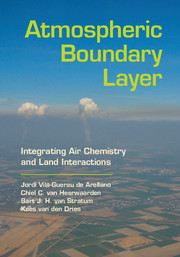Book contents
- Frontmatter
- Contents
- CLASS Software
- Preface
- Acknowledgments
- Part I The Land-Atmospheric Boundary Layer System
- Part II The Uncoupled System
- Part III The Coupled System
- 9 Atmosphere-Vegetation-Soil Interaction
- 10 Numerical Experiments: Atmosphere-Vegetation-Soil Interaction
- 11 A Dynamic Representation of Carbon Dioxide Exchange from the Vegetation and Soil
- 12 Sensitivity of the Atmosphere-Vegetation-Soil System to Climate Perturbations
- 13 Case Studies of More Complex Situations
- Part IV Processes Related to Boundary Layer Clouds
- Part V User's Guide: CLASS Modules and Variables
- Appendices
- Bibliography
- Index
12 - Sensitivity of the Atmosphere-Vegetation-Soil System to Climate Perturbations
from Part III - The Coupled System
Published online by Cambridge University Press: 05 July 2015
- Frontmatter
- Contents
- CLASS Software
- Preface
- Acknowledgments
- Part I The Land-Atmospheric Boundary Layer System
- Part II The Uncoupled System
- Part III The Coupled System
- 9 Atmosphere-Vegetation-Soil Interaction
- 10 Numerical Experiments: Atmosphere-Vegetation-Soil Interaction
- 11 A Dynamic Representation of Carbon Dioxide Exchange from the Vegetation and Soil
- 12 Sensitivity of the Atmosphere-Vegetation-Soil System to Climate Perturbations
- 13 Case Studies of More Complex Situations
- Part IV Processes Related to Boundary Layer Clouds
- Part V User's Guide: CLASS Modules and Variables
- Appendices
- Bibliography
- Index
Summary
The introduction of a representation of the dynamics of plants and soil (Chapter 11) enables us to study the fully coupled atmosphere-vegetation-soil system. As a result, however, we are now confronted by a system that is characterized by many degrees of freedom. Our existing knowledge, acquired by analysing heat, moisture, and momentum budgets, is now extended to determine how the carbon dioxide budget influences the thermodynamics and whether modifications of the heat and moisture budgets result in changes of CO2. The CO2 budget decoupled from the soil and vegetation processes was already introduced in Chapter 7.
At this point, we can take two different paths: to investigate the budgets and their interaction on the diurnal time-scale (as in previous chapters), or devote our analysis to determine how modifications in a process or variable lead to changes in the other variables. In taking the second path, we focus on a systematic analysis in order to answer the following questions: (a) How do ‘potential’ variations of the atmosphere, vegetation, and soil conditions influence the exchange of carbon dioxide and water vapour at the surface and the subsequent implications on the ABL? (b) What is the impact of these variations on the thermodynamic and carbon dioxide budgets?
Since we are now dealing with a complex system characterized by several interacting variables, we limit ourself to key long-term modifications (climate) that can affect the carbon and water cycle. We therefore adopt a larger climate perspective in formulating the research questions to be studied employing CLASS. In so doing, we define various scenarios with warmer mean temperatures, drought conditions, higher CO2 concentration levels, and global radiation dimming. We are then able to study the relevance, impact, and changes of the couplings and feedbacks among the various components of the atmosphere-land system due to changes of the large-scale (climate) forcing. We therefore assume that the time-scale of the ABL dynamics defined by the turbulent mixing is very short compared to the time-scale of the changes in the large-scale system (for instance, changes in the synoptic flow patterns or soil moisture modifications due to perturbed rainfall patterns).
- Type
- Chapter
- Information
- Atmospheric Boundary LayerIntegrating Air Chemistry and Land Interactions, pp. 148 - 155Publisher: Cambridge University PressPrint publication year: 2015



